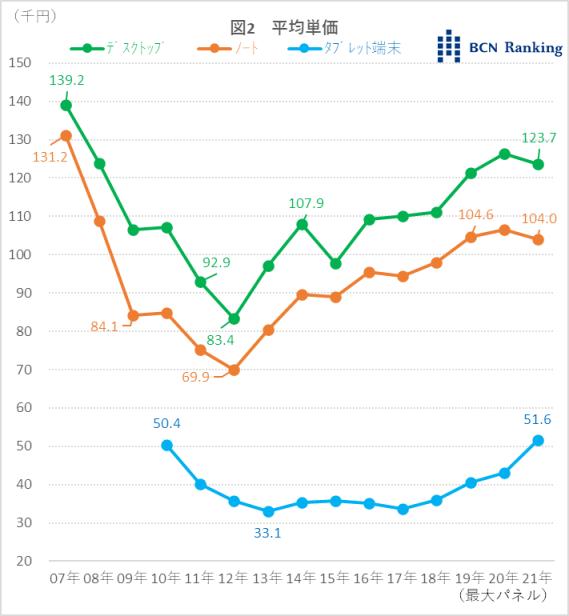Personal computer market trends from 2007 to 2015
Personal Computer Sales Index
Aggregating the actual sales data of consumer electronics mass retailers and online shops for the personal computer (PC) market, which includes notebooks, desktops, and tablet terminals, from 2007 to 2015. I looked back at BCN Ranking. We will calculate an index based on the total number of PCs sold in 2007 as "100.0" and track the changes in the market size. Notebooks accounted for about three-quarters of the market, and desktops accounted for the remainder. In 2007, tablet devices had not yet appeared. In 2008, with the advent of the "100 yen PC", the volume index expanded to "113.0". Although Windows 7 was released in 2009, low-spec, inexpensive netbooks running Windows XP boosted sales of notebooks, increasing the presence of notebooks in the market. The market expanded with the launch of the first iPad in May 2010, and the market expanded further in 2012 with the introduction of small tablet terminals in the 7-inch range, such as the first Nexus and iPad mini. From 2013 onwards, the presence of tablet terminals increased, and notebook sales decreased. In 2014, the index peaked at 178.4, largely due to the increase in sales of tablet devices. However, with the rise of smartphones and the extension of the useful life of PCs, the market size has continued to decline, and in 2018 it shrank to "114.1". In 2019, the index turned to expand again due to rush demand before the consumption tax hike from 8% to 10%, replacement demand due to the end of support for Windows 7 in 2020, and special demand due to the corona crisis. remained below the level of the previous year. Next, let's look at the movement of the average unit price. In 2007, both notebooks and desktops were in the 130,000 yen range. With the introduction of the 100-yen PC in 2008, the average unit price fell sharply, dropping below 100,000 yen for notebooks in 2009 and desktops in 2011. The average unit price of desktops fell to 83,400 yen. With the introduction of Windows 8-equipped PCs in October 2012, the average unit price turned upward. Desktops reached the 100,000 yen level in 2014, but notebooks hovered at the 90,000 yen level from 2014 to 2018, finally returning to the 100,000 yen level in 2019. On the other hand, the average unit price of tablet terminals has also fallen due to the appearance of small tablet terminals, and the average unit price has fallen by nearly 20,000 yen in four years to 33,100 yen. It remained at the 30,000 yen level until 2018, but recovered to the 40,000 yen level from 2019. The period when the average unit price rose coincided with the period when Huawei Technologies lost its market share due to US sanctions. Over the past 15 years, Japanese PC manufacturers have seen a dizzying array of mergers and spin-offs. First, NEC will establish a joint venture with Lenovo, and Fujitsu will also come under Lenovo's umbrella. Sony transferred its business to VAIO, and Toshiba inherited its business to Toshiba Client Solutions, but in the end it was acquired by Hon Hai's Sharp. Currently, the supply and demand balance of various materials including semiconductors has collapsed, and the severe situation will continue. In addition, the average unit price may return to the level of 15 years ago, as product prices are rising against the backdrop of material shortages. *"BCN Ranking" is a sales database that collects and aggregates sales data for personal computers, digital home appliances, etc. from major home appliance mass retailers and online shops nationwide every day. ) is covered.
